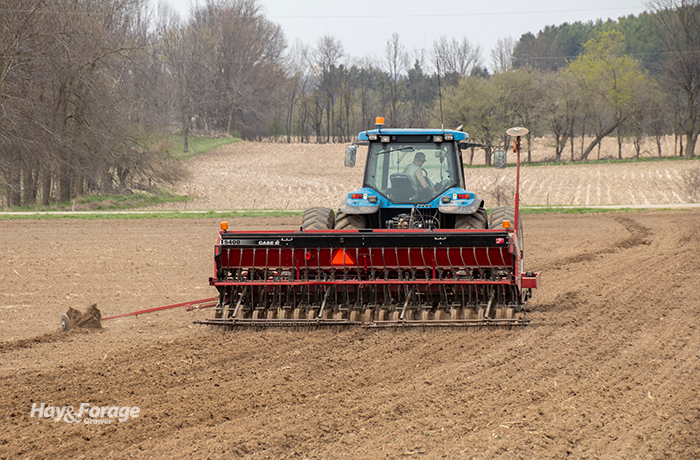
A vigorous alfalfa stand most likely points back to a well-timed and carefully executed seeding. In the Midwest, alfalfa seeding dates can fall on either shoulder of the growing season with both times of year offering its own list of planting condition pros and cons.
In addition to preparing the site and amending soil fertility, one key piece of alfalfa establishment is seeding rate. Other factors such as drill performance, seed placement, soil moisture, and the weather also contribute to stand density and total yield, but a common seeding rate recommendation is 10 to 15 pounds of pure live alfalfa seed per acre.
Despite this, researchers at South Dakota State University suggest alfalfa is commonly seeded at much higher rates than necessary with little improvement to stand density or yield. To test their hypothesis, they conducted a three-year study to confirm that current seeding rate recommendations are effective.
No need for more seed
The results of the study were included in a recent issue of the Midwest Forage Association’s Clippings newsletter. In mid-April 2021, the researchers established randomized plots of alfalfa seeded at 5, 7.5, 10, 12.5, 15, and 20 pounds per acre in Beresford, S.D. Each plot was replicated four times and divided into two sections for inoculated and noninoculated seed, for which data was analyzed separately.
No data was collected during the establishment year due to extremely dry weather that hindered plant growth after seedling emergence. The researchers measured stem density and total season yield across four cuttings in 2022 and 2023; however, they note dry conditions persisted throughout the entire study.
Plots seeded at 12.5 pounds per acre realized the greatest total yield 9.56 tons per acre over two years, confirming that alfalfa stands could generate favorable yields when seeding rates are lower than what is typically implemented. These treatment plots also produced the best first-cut yields at 2.74 tons per acre on average.
“Although alfalfa yields were low in this study as plots were under drought conditions in all or in portions of each year, data is still consistent that a 10- to 15-pound per acre seeding rate was sufficient to reach adequate yields,” the researchers write.
The researchers note plots seeded at 15 and 20 pounds per acre also realized good average first-cut yields at 2.47 and 2.43 tons per acre, respectively, but total season yield for these treatments fell behind that of alfalfa seeded at 12.5 pounds per acre. Moreover, plots that were planted at 15 pounds of alfalfa per acre had the highest stem counts in the study, but this did not equate to a better total season yield on average.
The researchers note that stem density tapered off in stands where seeding rate exceeded 15 pounds per acre due to alfalfa’s ability to self-thin, further supporting the cause for more conservative seeding rates. Other studies have shown that forage quality does not improve with greater seeding rates, either.
One unexpected outcome of the experiment was that total season yield for noninoculated alfalfa seeded at 12.5 pounds per acre was greater than that of inoculated alfalfa. This was also the case when alfalfa was seeded at 5, 10, and 20 pounds per acre. The researchers suspect the amount of the bacteria that was targeted with inoculation was already abundant in the soil, therefore eliminating the efficiency of the treated seed in later cuttings.

